Anthony K. H. Tung
National University of Singapore
Text Embeddings Should Capture Implicit Semantics, Not Just Surface Meaning
Jun 10, 2025Abstract:This position paper argues that the text embedding research community should move beyond surface meaning and embrace implicit semantics as a central modeling goal. Text embedding models have become foundational in modern NLP, powering a wide range of applications and drawing increasing research attention. Yet, much of this progress remains narrowly focused on surface-level semantics. In contrast, linguistic theory emphasizes that meaning is often implicit, shaped by pragmatics, speaker intent, and sociocultural context. Current embedding models are typically trained on data that lacks such depth and evaluated on benchmarks that reward the capture of surface meaning. As a result, they struggle with tasks requiring interpretive reasoning, speaker stance, or social meaning. Our pilot study highlights this gap, showing that even state-of-the-art models perform only marginally better than simplistic baselines on implicit semantics tasks. To address this, we call for a paradigm shift: embedding research should prioritize more diverse and linguistically grounded training data, design benchmarks that evaluate deeper semantic understanding, and explicitly frame implicit meaning as a core modeling objective, better aligning embeddings with real-world language complexity.
PRISM: A Framework for Producing Interpretable Political Bias Embeddings with Political-Aware Cross-Encoder
May 30, 2025Abstract:Semantic Text Embedding is a fundamental NLP task that encodes textual content into vector representations, where proximity in the embedding space reflects semantic similarity. While existing embedding models excel at capturing general meaning, they often overlook ideological nuances, limiting their effectiveness in tasks that require an understanding of political bias. To address this gap, we introduce PRISM, the first framework designed to Produce inteRpretable polItical biaS eMbeddings. PRISM operates in two key stages: (1) Controversial Topic Bias Indicator Mining, which systematically extracts fine-grained political topics and their corresponding bias indicators from weakly labeled news data, and (2) Cross-Encoder Political Bias Embedding, which assigns structured bias scores to news articles based on their alignment with these indicators. This approach ensures that embeddings are explicitly tied to bias-revealing dimensions, enhancing both interpretability and predictive power. Through extensive experiments on two large-scale datasets, we demonstrate that PRISM outperforms state-of-the-art text embedding models in political bias classification while offering highly interpretable representations that facilitate diversified retrieval and ideological analysis. The source code is available at https://github.com/dukesun99/ACL-PRISM.
Don't Reinvent the Wheel: Efficient Instruction-Following Text Embedding based on Guided Space Transformation
May 30, 2025
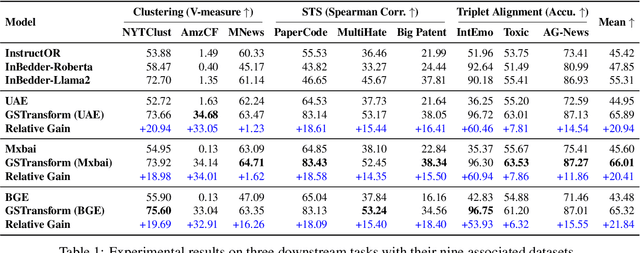
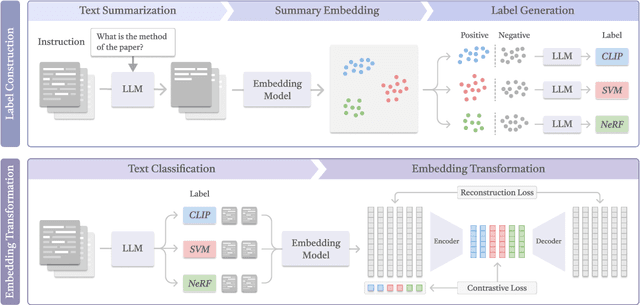

Abstract:In this work, we investigate an important task named instruction-following text embedding, which generates dynamic text embeddings that adapt to user instructions, highlighting specific attributes of text. Despite recent advancements, existing approaches suffer from significant computational overhead, as they require re-encoding the entire corpus for each new instruction. To address this challenge, we propose GSTransform, a novel instruction-following text embedding framework based on Guided Space Transformation. Our key observation is that instruction-relevant information is inherently encoded in generic embeddings but remains underutilized. Instead of repeatedly encoding the corpus for each instruction, GSTransform is a lightweight transformation mechanism that adapts pre-computed embeddings in real time to align with user instructions, guided by a small amount of text data with instruction-focused label annotation. We conduct extensive experiments on three instruction-awareness downstream tasks across nine real-world datasets, demonstrating that GSTransform improves instruction-following text embedding quality over state-of-the-art methods while achieving dramatic speedups of 6~300x in real-time processing on large-scale datasets. The source code is available at https://github.com/YingchaojieFeng/GSTransform.
A General Framework for Producing Interpretable Semantic Text Embeddings
Oct 04, 2024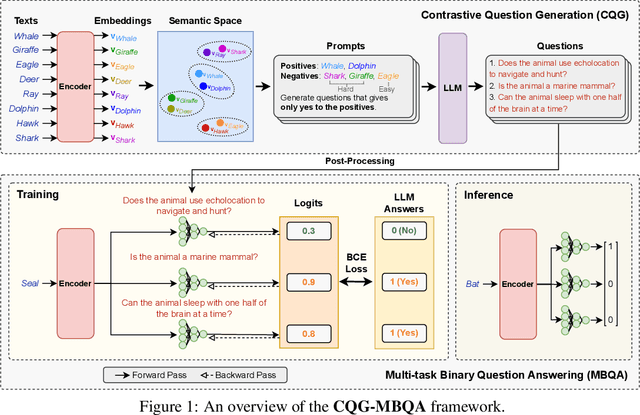

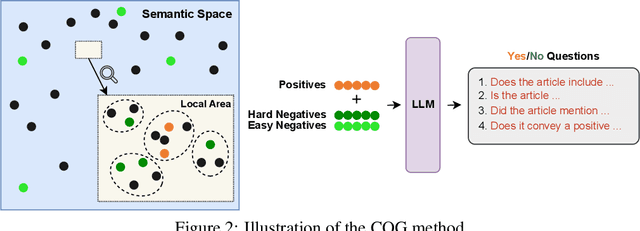
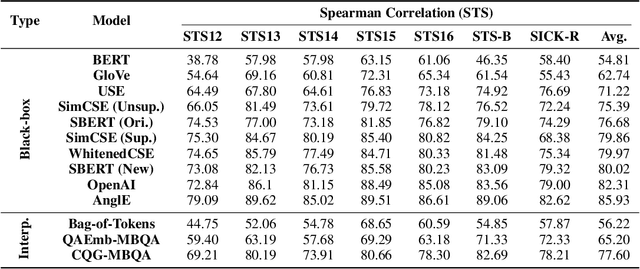
Abstract:Semantic text embedding is essential to many tasks in Natural Language Processing (NLP). While black-box models are capable of generating high-quality embeddings, their lack of interpretability limits their use in tasks that demand transparency. Recent approaches have improved interpretability by leveraging domain-expert-crafted or LLM-generated questions, but these methods rely heavily on expert input or well-prompt design, which restricts their generalizability and ability to generate discriminative questions across a wide range of tasks. To address these challenges, we introduce \algo{CQG-MBQA} (Contrastive Question Generation - Multi-task Binary Question Answering), a general framework for producing interpretable semantic text embeddings across diverse tasks. Our framework systematically generates highly discriminative, low cognitive load yes/no questions through the \algo{CQG} method and answers them efficiently with the \algo{MBQA} model, resulting in interpretable embeddings in a cost-effective manner. We validate the effectiveness and interpretability of \algo{CQG-MBQA} through extensive experiments and ablation studies, demonstrating that it delivers embedding quality comparable to many advanced black-box models while maintaining inherently interpretability. Additionally, \algo{CQG-MBQA} outperforms other interpretable text embedding methods across various downstream tasks.
Towards Controllable Time Series Generation
Mar 06, 2024Abstract:Time Series Generation (TSG) has emerged as a pivotal technique in synthesizing data that accurately mirrors real-world time series, becoming indispensable in numerous applications. Despite significant advancements in TSG, its efficacy frequently hinges on having large training datasets. This dependency presents a substantial challenge in data-scarce scenarios, especially when dealing with rare or unique conditions. To confront these challenges, we explore a new problem of Controllable Time Series Generation (CTSG), aiming to produce synthetic time series that can adapt to various external conditions, thereby tackling the data scarcity issue. In this paper, we propose \textbf{C}ontrollable \textbf{T}ime \textbf{S}eries (\textsf{CTS}), an innovative VAE-agnostic framework tailored for CTSG. A key feature of \textsf{CTS} is that it decouples the mapping process from standard VAE training, enabling precise learning of a complex interplay between latent features and external conditions. Moreover, we develop a comprehensive evaluation scheme for CTSG. Extensive experiments across three real-world time series datasets showcase \textsf{CTS}'s exceptional capabilities in generating high-quality, controllable outputs. This underscores its adeptness in seamlessly integrating latent features with external conditions. Extending \textsf{CTS} to the image domain highlights its remarkable potential for explainability and further reinforces its versatility across different modalities.
Diversity-Aware $k$-Maximum Inner Product Search Revisited
Feb 21, 2024



Abstract:The $k$-Maximum Inner Product Search ($k$MIPS) serves as a foundational component in recommender systems and various data mining tasks. However, while most existing $k$MIPS approaches prioritize the efficient retrieval of highly relevant items for users, they often neglect an equally pivotal facet of search results: \emph{diversity}. To bridge this gap, we revisit and refine the diversity-aware $k$MIPS (D$k$MIPS) problem by incorporating two well-known diversity objectives -- minimizing the average and maximum pairwise item similarities within the results -- into the original relevance objective. This enhancement, inspired by Maximal Marginal Relevance (MMR), offers users a controllable trade-off between relevance and diversity. We introduce \textsc{Greedy} and \textsc{DualGreedy}, two linear scan-based algorithms tailored for D$k$MIPS. They both achieve data-dependent approximations and, when aiming to minimize the average pairwise similarity, \textsc{DualGreedy} attains an approximation ratio of $1/4$ with an additive term for regularization. To further improve query efficiency, we integrate a lightweight Ball-Cone Tree (BC-Tree) index with the two algorithms. Finally, comprehensive experiments on ten real-world data sets demonstrate the efficacy of our proposed methods, showcasing their capability to efficiently deliver diverse and relevant search results to users.
From Zero to Hero: Detecting Leaked Data through Synthetic Data Injection and Model Querying
Oct 06, 2023



Abstract:Safeguarding the Intellectual Property (IP) of data has become critically important as machine learning applications continue to proliferate, and their success heavily relies on the quality of training data. While various mechanisms exist to secure data during storage, transmission, and consumption, fewer studies have been developed to detect whether they are already leaked for model training without authorization. This issue is particularly challenging due to the absence of information and control over the training process conducted by potential attackers. In this paper, we concentrate on the domain of tabular data and introduce a novel methodology, Local Distribution Shifting Synthesis (\textsc{LDSS}), to detect leaked data that are used to train classification models. The core concept behind \textsc{LDSS} involves injecting a small volume of synthetic data--characterized by local shifts in class distribution--into the owner's dataset. This enables the effective identification of models trained on leaked data through model querying alone, as the synthetic data injection results in a pronounced disparity in the predictions of models trained on leaked and modified datasets. \textsc{LDSS} is \emph{model-oblivious} and hence compatible with a diverse range of classification models, such as Naive Bayes, Decision Tree, and Random Forest. We have conducted extensive experiments on seven types of classification models across five real-world datasets. The comprehensive results affirm the reliability, robustness, fidelity, security, and efficiency of \textsc{LDSS}.
TSGBench: Time Series Generation Benchmark
Sep 07, 2023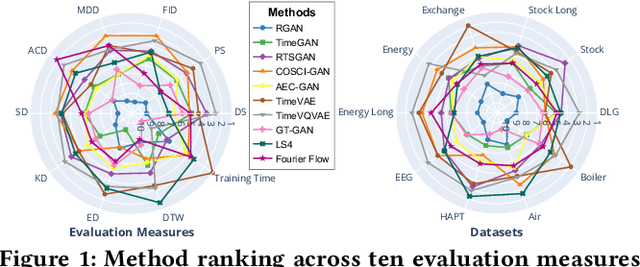
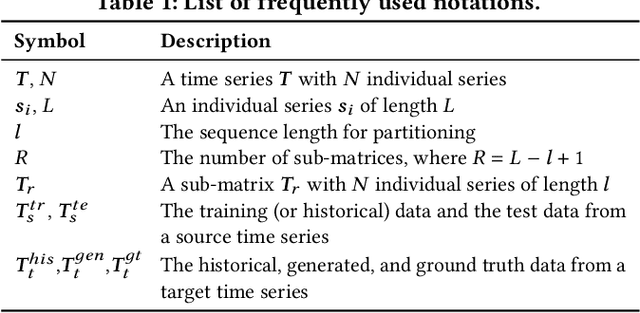

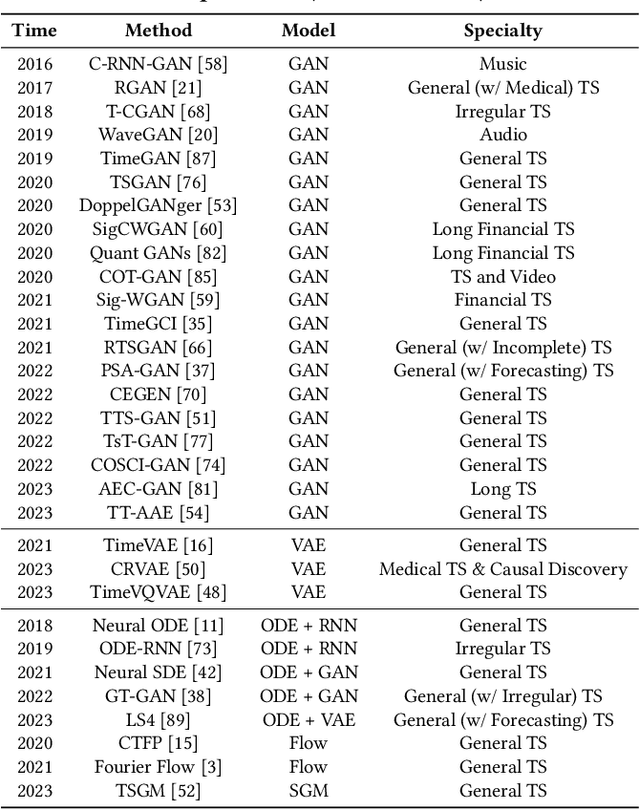
Abstract:Synthetic Time Series Generation (TSG) is crucial in a range of applications, including data augmentation, anomaly detection, and privacy preservation. Although significant strides have been made in this field, existing methods exhibit three key limitations: (1) They often benchmark against similar model types, constraining a holistic view of performance capabilities. (2) The use of specialized synthetic and private datasets introduces biases and hampers generalizability. (3) Ambiguous evaluation measures, often tied to custom networks or downstream tasks, hinder consistent and fair comparison. To overcome these limitations, we introduce \textsf{TSGBench}, the inaugural TSG Benchmark, designed for a unified and comprehensive assessment of TSG methods. It comprises three modules: (1) a curated collection of publicly available, real-world datasets tailored for TSG, together with a standardized preprocessing pipeline; (2) a comprehensive evaluation measures suite including vanilla measures, new distance-based assessments, and visualization tools; (3) a pioneering generalization test rooted in Domain Adaptation (DA), compatible with all methods. We have conducted extensive experiments across ten real-world datasets from diverse domains, utilizing ten advanced TSG methods and twelve evaluation measures, all gauged through \textsf{TSGBench}. The results highlight its remarkable efficacy and consistency. More importantly, \textsf{TSGBench} delivers a statistical breakdown of method rankings, illuminating performance variations across different datasets and measures, and offering nuanced insights into the effectiveness of each method.
Lightweight-Yet-Efficient: Revitalizing Ball-Tree for Point-to-Hyperplane Nearest Neighbor Search
Feb 21, 2023Abstract:Finding the nearest neighbor to a hyperplane (or Point-to-Hyperplane Nearest Neighbor Search, simply P2HNNS) is a new and challenging problem with applications in many research domains. While existing state-of-the-art hashing schemes (e.g., NH and FH) are able to achieve sublinear time complexity without the assumption of the data being in a unit hypersphere, they require an asymmetric transformation, which increases the data dimension from $d$ to $\Omega(d^2)$. This leads to considerable overhead for indexing and incurs significant distortion errors. In this paper, we investigate a tree-based approach for solving P2HNNS using the classical Ball-Tree index. Compared to hashing-based methods, tree-based methods usually require roughly linear costs for construction, and they provide different kinds of approximations with excellent flexibility. A simple branch-and-bound algorithm with a novel lower bound is first developed on Ball-Tree for performing P2HNNS. Then, a new tree structure named BC-Tree, which maintains the Ball and Cone structures in the leaf nodes of Ball-Tree, is described together with two effective strategies, i.e., point-level pruning and collaborative inner product computing. BC-Tree inherits both the low construction cost and lightweight property of Ball-Tree while providing a similar or more efficient search. Experimental results over 16 real-world data sets show that Ball-Tree and BC-Tree are around 1.1$\sim$10$\times$ faster than NH and FH, and they can reduce the index size and indexing time by about 1$\sim$3 orders of magnitudes on average. The code is available at \url{https://github.com/HuangQiang/BC-Tree}.
SAH: Shifting-aware Asymmetric Hashing for Reverse $k$-Maximum Inner Product Search
Nov 23, 2022Abstract:This paper investigates a new yet challenging problem called Reverse $k$-Maximum Inner Product Search (R$k$MIPS). Given a query (item) vector, a set of item vectors, and a set of user vectors, the problem of R$k$MIPS aims to find a set of user vectors whose inner products with the query vector are one of the $k$ largest among the query and item vectors. We propose the first subquadratic-time algorithm, i.e., Shifting-aware Asymmetric Hashing (SAH), to tackle the R$k$MIPS problem. To speed up the Maximum Inner Product Search (MIPS) on item vectors, we design a shifting-invariant asymmetric transformation and develop a novel sublinear-time Shifting-Aware Asymmetric Locality Sensitive Hashing (SA-ALSH) scheme. Furthermore, we devise a new blocking strategy based on the Cone-Tree to effectively prune user vectors (in a batch). We prove that SAH achieves a theoretical guarantee for solving the RMIPS problem. Experimental results on five real-world datasets show that SAH runs 4$\sim$8$\times$ faster than the state-of-the-art methods for R$k$MIPS while achieving F1-scores of over 90\%. The code is available at \url{https://github.com/HuangQiang/SAH}.
 Add to Chrome
Add to Chrome Add to Firefox
Add to Firefox Add to Edge
Add to Edge